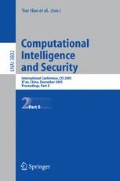Abstract
In this paper, we focus on the Condorcet voting scheme in which each voter votes with the full order of the candidates according to preference, and the result of the election is determined by one-on-one comparisons between each candidate. We propose the Condorcet electronic voting scheme that is secure, universally verifiable and satisfying one-on-one comparison privacy. Furthermore the result of the election can be determined without revealing the order of the candidates which each voter specified. We use a matrix to represent the order of all the candidates according to preference, and satisfy one-on-one comparison privacy using homomorphic property.
Access this chapter
Tax calculation will be finalised at checkout
Purchases are for personal use only
Preview
Unable to display preview. Download preview PDF.
References
Benaloh, J.: Verifiable Secret-Ballot Elections. PhD thesis, Yale University, Department of Computer Science Department, New Haven, CT (September 1987)
Cramer, R., Franklin, M., Schoenmakers, B., Yung, M.: Multi-authority secret ballot elections with linear work. In: Maurer, U.M. (ed.) EUROCRYPT 1996. LNCS, vol. 1070, pp. 72–83. Springer, Heidelberg (1996)
Cramer, R., Gennaro, R., Schoenmakers, B.: A secure and optimally efficient multi-authority election scheme. In: Fumy, W. (ed.) EUROCRYPT 1997. LNCS, vol. 1233, pp. 103–118. Springer, Heidelberg (1997)
Chaum, D.: Untraceable electronic mail, return addresses, and digital pseudonyms. Communications of the ACM 24(2), 84–88 (1981)
Desmedt, Y.: Threshold cryptography. European Transactions on Telecommunications 5(4), 449–457 (1994)
Dasgupta, P., Maskin, E.: The Fairest Vote of all. SCIENTIFIC AMERICAN 290, 64–69 (2004)
Duncan, B.: The Theory of Committees and Election. Cambridge University Press, Cambridge (JF1001, B49, ISBN 0-89838-189-4) (1986)
ElGamal, T.: A public-key cryptosystem and a signature scheme based on discrete logarithms. IEEE Transactions on Information Theory, IT 31(4), 469–472 (1985)
Fishburn, P.: Condorcet Social Choice Functions. SIAM Journal of Applied Mathematics 33, 469–489 (1977)
Furukawa, J., Miyauchi, H., Mori, K., Obana, S., Sako, K.: An Implementation of a Universally Verifiable Electronic Voting Scheme based on Shuffling. In: Blaze, M. (ed.) FC 2002. LNCS, vol. 2357, pp. 16–30. Springer, Heidelberg (2003)
Fujioka, A., Okamoto, T., Ohta, K.: A Practical secret Voting Scheme for Large Scale Elections. In: AUSCRYPTO 1992, pp. 244–251. Springer, Heidelberg (1992)
Furukawa, J., Sako, K.: An Efficient Scheme for Proving an Shuffle. In: Kilian, J. (ed.) CRYPTO 2001. LNCS, vol. 2139, pp. 368–387. Springer, Heidelberg (2001)
Hirt, M., Sako, K.: Efficient receipt-free voting based on homomorphic encryption. In: Preneel, B. (ed.) EUROCRYPT 2000. LNCS, vol. 1807, pp. 539–556. Springer, Heidelberg (2000)
Iain, M., Fiona, H.: Condorcet:Foundations of Social Choice and Political Theory. Nuffield College. Edward Elgar Publishing Limited (1994)
Jakobsson, M., Juels, A.: Mix and Match:Secure Function Evaluation via Ciphertexts. In: Okamoto, T. (ed.) ASIACRYPT 2000. LNCS, vol. 1976, pp. 162–177. Springer, Heidelberg (2000)
Okamoto, T.: Receipt-free electronic voting schemes for large scale elections. In: Christianson, B., Lomas, M. (eds.) Security Protocols 1997. LNCS, vol. 1361, pp. 25–35. Springer, Heidelberg (1998)
Taylor, A.: Mathematics and politics: strategy, voting, power and proof. Springer, New York (ISBN 0-387-94500-8) (1995)
Wang, C.J., Leung, H.F.: A Secure and Fully Private Borda Voting Protocol with Universal Verifiability. 28th COMPSAC 1, 224–229 (2004)
Author information
Authors and Affiliations
Editor information
Editors and Affiliations
Rights and permissions
Copyright information
© 2005 Springer-Verlag Berlin Heidelberg
About this paper
Cite this paper
Lee, Y.C., Doi, H. (2005). On the Security of Condorcet Electronic Voting Scheme. In: Hao, Y., et al. Computational Intelligence and Security. CIS 2005. Lecture Notes in Computer Science(), vol 3802. Springer, Berlin, Heidelberg. https://doi.org/10.1007/11596981_5
Download citation
DOI: https://doi.org/10.1007/11596981_5
Publisher Name: Springer, Berlin, Heidelberg
Print ISBN: 978-3-540-30819-5
Online ISBN: 978-3-540-31598-8
eBook Packages: Computer ScienceComputer Science (R0)

